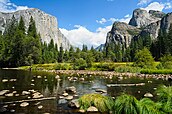User:Allard
Hello and a warm welcome to all my fellow Wikipedians. How nice of you to drop in to see who I am!
Morning>
Wikipedia & me:
[edit]How I discovered Wikipedia, I do not remember. But from being a reader I slowly became a contributor. Although I don't work that much on Wikipedia I do see myself as a Wikipedian. I don't go searching on Wikipedia what I can edit next, I edit what I find and want to do. This means I add and mainly improve a lot of small things and only rarely I make large edits.
My work:
[edit]Articles I've started on Wikipedia:
- Fort Knox Bullion Depository
- Animals are Beautiful People
- Template:David Attenborough Television Series
- Template:Malta Islands
Images I made for Wikipedia:
 Dutch lower house as from 2006
Dutch lower house as from 2006 New image of the Netherlands Air Force Roundel
New image of the Netherlands Air Force RoundelMap on membership of the League of Nations
United Nations membership map
 Improved image of the British Helgoland flag
Improved image of the British Helgoland flag New image showing the current flag of Hel(i)goland
New image showing the current flag of Hel(i)goland
Article guide:
[edit]A list of articles worth looking at, if one can find them:
- Antidisestablishmentarianism
- Ball's Pyramid
- British Isles (terminology)
- Eadweard Muybridge
- Gunpowder Plot
- Horace de Vere Cole
- Humphrey (cat)
- Islomania
- List of countries by date of nationhood
- List of flags
- List of people who died on their birthdays
- List of regnal numerals of future British monarchs
- List of unusual deaths
- Northwest Angle
- Quadripoint
- Racetrack Playa
- Rule of tincture
- San Gimignano
- Transcontinental country
- Undivided India & Partition of India
- Voyager Golden Record
- Web colors
- Winchester Mystery House
And there's always the Random article
And to all citizens of the European Union, please read this: Oneseat.eu
News
[edit]- Flooding in Nepal leaves more than 200 people dead, including 37 in the nation's capital, Kathmandu.
- In Australian rules football, the Brisbane Lions defeat the Sydney Swans to win the AFL Grand Final (Norm Smith Medal winner Will Ashcroft pictured).
- Hezbollah leader Hassan Nasrallah is killed by an Israeli airstrike in Dahieh, Lebanon.
- Hurricane Helene leaves more than 100 people dead across the southeastern United States.
- British actress Maggie Smith dies at the age of 89.
Selected anniversaries
[edit]October 1: Unification Day in Cameroon (1961); National Day in China (1949); Independence Day in Tuvalu (1978); Defenders Day in Ukraine (2015)
- 959 – Edgar acceded to the English throne upon the death of his brother Eadwig.
- 1386 – The Wonderful Parliament met at Westminster Abbey to address King Richard II's need for money, but soon changed focus to the reform of his administration.
- 1890 – At the encouragement of preservationist John Muir and writer Robert Underwood Johnson, the U.S. Congress established Yosemite National Park (pictured) in California.
- 1918 – First World War: British and Arab troops captured Damascus from the Ottoman Empire.
- 2003 – A levy was imposed on the hiring of foreign domestic helpers in Hong Kong, who numbered in the hundreds of thousands at the time.
- Kong Wei (d. 895)
- Helen Mayo (b. 1878)
- Jimmy Carter (b. 1924)
- Nani Alapai (d. 1928)
Did you know...
[edit]- ... that many people who recover from tuberculosis lose more than half of their lung capacity (example pictured)?
- ... that Henry Kailimai and his Hawaiian Quintet were hired by Henry Ford to serve as official musicians for the Ford Motor Company?
- ... that when the Edward S. Harkness House was built, its owner took the address from his neighbor?
- ... that a New Testament manuscript was "barbarously scored with red chalk" by a book publisher?
- ... that Thomas Bertrand-Hudon is the first professional football player to wear a Guardian Cap during a regular season game?
- ... that the 1998 cyberpunk short story "CyberJoly Drim" caused a controversy in the Polish science fiction and fantasy community?
- ... that Ajah Pritchard-Lolo is Vanuatu's first Olympic weightlifter?
- ... that many hapa haole songs were written by non-Hawaiians and featured nonsensical, faux-Hawaiian lyrics?
- ... that Shoko Ikeda once admitted that Haruhi Suzumiya, a character she designed, was "just like me"?
Today's featured article
[edit]The Founding Ceremony of the Nation is a 1953 oil painting by Chinese artist Dong Xiwen. It depicts Mao Zedong and other Communist officials inaugurating the People's Republic of China at Tiananmen Square in Beijing on October 1, 1949. A prominent example of socialist realism, it is one of the most celebrated works of official Chinese art. After the Communists took control of China, they sought to memorialize their success with art. Dong was chosen to reproduce the October 1 ceremony in a painting, and completed it in a folk art style, drawing on historical Chinese art. When Mao viewed it and liked it, it was assured of success, and was widely reproduced. After government purges, Dong was ordered to remove Gao Gang in 1954 and Liu Shaoqi in 1967. In 1972 a copy was made by other artists to accommodate another deletion. After the purged officials were rehabilitated, the replica was modified in 1979 to include them. Both canvases are in the National Museum of China in Beijing. (Full article...)











